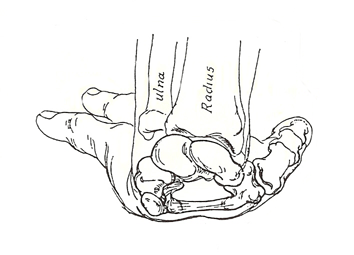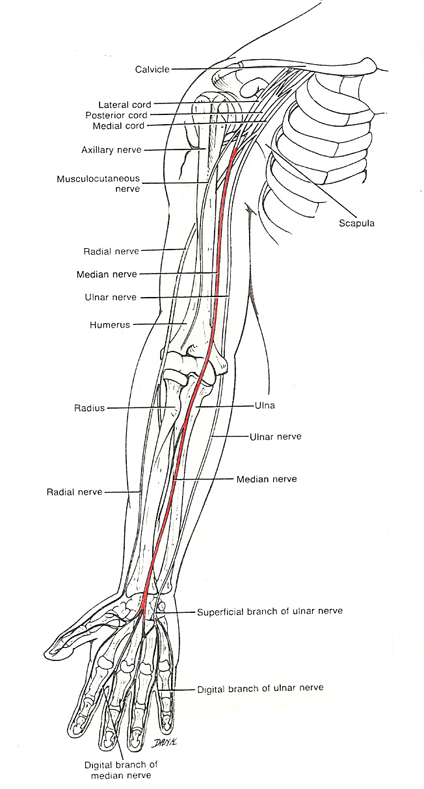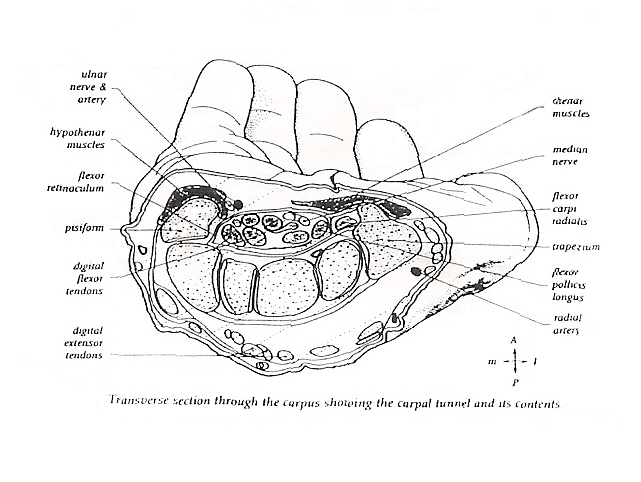|
Carpal Tunnel Syndrome
| Click for larger image... |

|
The carpals, or bones in the wrist, form a tunnel through
which the tendons of the hand muscles travel.
The tendons are kept in place by ligaments. The muscles in
the anterior forearm, or on the side of the palm, help to flex the wrist.
| Click for larger image... |

|
These muscles are primarily supplied by the Median Nerve which
begins in the neck and travels the length of the arm.
The tendons of the forearm muscles as well as arteries, veins and Median Nerve all travel through the Carpal Tunnel.
When inflamed or swollen, often due to overuse, the muscle
tendons have difficulty smoothly sliding within the Carpal Tunnel. This can result in CARPAL TUNNEL SYNDROME
(CTS) with its various symptoms, especially if the Median Nerve is also comprised within the confines of the
Tunnel. Continued friction and inflammation causes a cycle of pain and limitation.
Due to overuse, the tendons
of the flexor muscles will swell within this tunnel. The painful symptoms of CTS are produced by the compression of
the Median Nerve. This cycle of friction and inflammation continues to increase the pressure on the nerve.
Occupations that require
repetitive hand motions are most commonly associated with CTS. Typists, keyboard operators, carpenters, bakers,
writers, musicians, artists, and those who have occupations with similar requirements affecting
the hands and wrists are most prone to the disorder. Compression or low grade muscular spasm in the neck region
can add to the symptoms of CTS.
| Click for larger image... |

|
Symptoms:
Pain and numbness in the anterior wrist and palmer surface of the hand. Difficulty gripping, tingling, pins-and-needles
sensation, stiffness, and burning. Which is often localized to the index, middle and ring fingers, and may travel the
entire length of arm and neck.
Healing strategies:
If possible, try to reduce the stress on the affected area
by taking a break from the offending
activity.
Stretch and relax daily, concentrating on the neck, chest, arms and hands.
Check with your physician to see if it is advisable to take
an anti-inflammatory medication such
as Aspirin or Ibuprofen.
The application of ice or a cold pack for twenty minutes, immediately
following stressful activity to the area can help to control inflammation.
Be sure to place a light towel
between the skin and cold pack to protect the skin.
Before retiring, the application of heat,
such as a heating pad, may be beneficial as it will encourage blood flow through the affected area. Again, twenty minutes
of application is advised.
Wrist splints will help keep the wrist straight, which in turn
takes the pressure off the nerve. With your physician's permission, seek a support that has a metal insert and secures
with velcro. Support is good, however, be careful not to secure the splint too tightly - remember we are trying
to take pressure off the wrist.
Ask your physician about Vitamin B6
and its effect upon CTS. Many sufferers have a B6 deficiency which may be alleviated with vitamin supplements.
As a natural diuretic, B6 may reduce swelling, nerve inflammation, and spasms.
Follow
your physician's dosage recommendations.
The best natural sources for Vitamin B include brewer's yeast, wheat bran,
wheat germ, cantaloupe, bananas, avocados, green leafy vegetables, carrots, peanuts, pecans, blackstrap molasses, milk, eggs,
and beef.
Here's a link for more information on Vitamin B.
Acupuncture treatment has proven effective in some cases and should be explored by those interested
in this type of treatment.
My number one suggestion, of course...
Massage.
Massage
has been proven extremely effective, as it aids in reducing or eliminating accumulated
tension. Reduced muscular tension in the neck, shoulder, arm regions, and especially in the flexor muscles
of the wrist, can take 'pressure' off the nervous tissue structures in the area. Massage promotes
the release of endorphins, the body's natural pain relievers. Improved circulation can reduce
swelling, and relief may be noted after only one treatment.
The most radical treatment approach would be
surgical intervention. This would be a last resort as relief may not be permanent if the offending
repetitive activity is continued over time.
For those with CTS, there are many avenues of treatment.
It is best to use those that are least invasive, and ones with minimal negative effects.
|